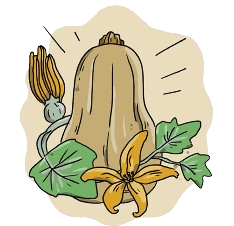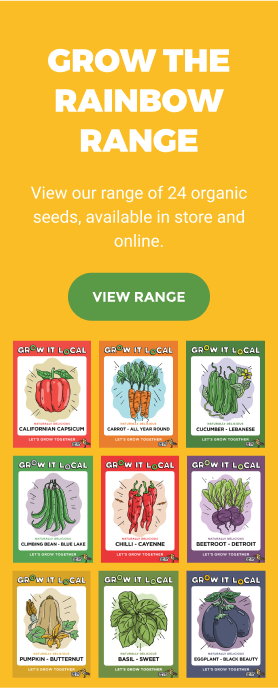How to grow Pumpkin Butternut
Buy Seeds
How to grow
Join Our Community
Learn to grow and cook healthy, delicious, organic food at home by joining our seasonal grow-alongs.
Join Our Community
Learn to grow and cook healthy, delicious, organic food at home by joining our seasonal grow-alongs.
Background
The name ‘butternut’ is derived from its smooth, buttery texture and sweet flavour, which sets it apart from other pumpkin varieties. Its elongated shape and tan-coloured skin make it easy to distinguish from other varieties of pumpkins
The origin of pumpkins can be traced to Central and South America, where it is believed to have been first domesticated over 10,000 years ago
The indigenous people of the Americas cultivated and traded butternut pumpkin, it gradually spread to different regions. The explorations of Christopher Columbus and other European explorers played a crucial role in introducing this vegetable to Europe.
By the 16th century, butternut pumpkin had made its way to other parts of the world through trade and exploration. European colonists and settlers brought it back to North America, where it thrived in various climates.
Health Benefits
Eating homegrown, organic butternut pumpkin is good for you!
It’s rich in vitamins A, C, and E and minerals like potassium and magnesium
Eating butternut pumpkin can support immune function and promote healthy vision and skin due to its high beta-carotene content. The fibre in butternut pumpkin aids digestion and supports a healthy gut. It also contains antioxidants that help combat oxidative stress and inflammation. Additionally, the potassium content contributes to heart health and blood pressure regulation.
Growing Tips and Tricks
Location:
Butternut pumpkin thrives in warm climates with full sun exposure. Choose a location in your garden that receives at least 6-8 hours of direct sunlight daily. The soil should be well-draining, fertile, and rich in organic matter.
Watering:
Butternut pumpkins require regular and consistent watering, especially during dry periods. Keep the soil evenly moist but not waterlogged. In hot weather, you may need to water the plants daily
Problems:
Pest Control: Keep an eye out for common pumpkin pests such as aphids, squash bugs, and vine borers. Use neem oil to control any pest infestations.
Diseases: Butternut pumpkins can be susceptible to diseases like powdery mildew and downy mildew. To prevent these issues, avoid overhead watering and provide good air circulation around the plants.
Fruit Rot: If the pumpkins come into contact with wet soil, they may be at risk of rotting. To prevent this, place straw or mulch under the developing fruits to keep them elevated and reduce contact with the soil.
Pollination Issues: In some cases, pumpkin plants may experience poor fruit set due to inadequate pollination. To improve fruit set, you can hand-pollinate the female flowers using a small brush or cotton swab.
Harvest:
Butternut pumpkins are ready for harvest when their skin has turned fully tan and hardened. The stem should also be dry and starting to detach from the vine. Use a sharp knife or pruning shears to cut the pumpkins from the vine, leaving a short stem attached.
Patch to plate
Thin skinned and full of subtly sweet flesh, butternut pumpkins are incredibly versatile in the kitchen. Here’s a couple of ideas to get you inspired to create something delicious with your homegrown butternut pumpkins
- Roasted pumpkin soup (obviously!) Roasting the pumpkin before blending the soup helps deepen and develop the already amazing flavours of that homegrown pumpkin!
- Roasted and served with chilli, feta and herbs
- Baked with carrot and chocolate into a delicious cake!




